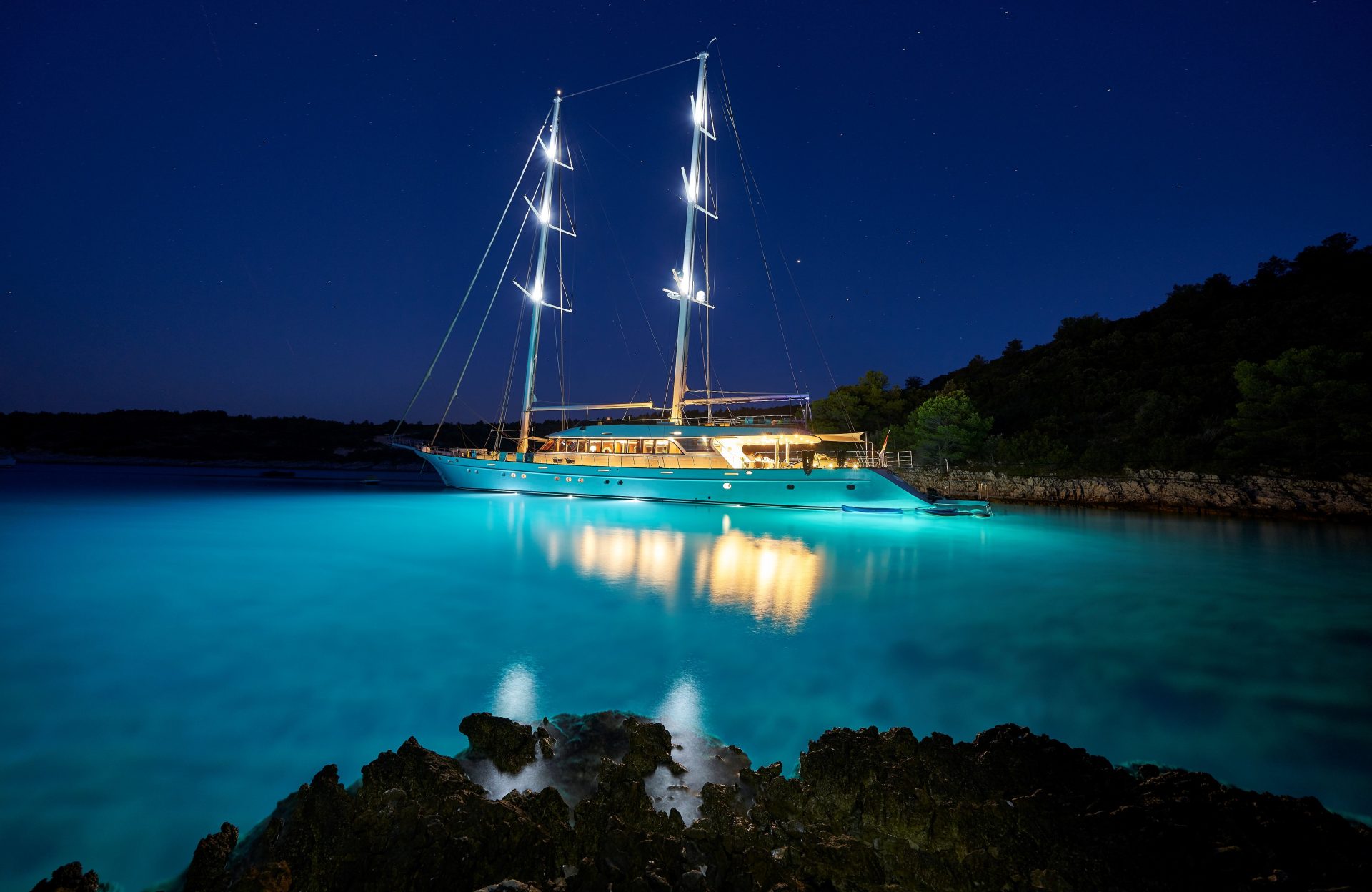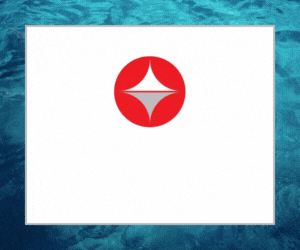Whether you’re a seasoned crew member or embarking on a career in the Superyacht industry, knowing and understanding nautical terms is essential. In this glossary, we take you through the many terms that form the backbone of communication on Superyachts (and similar vessels), ensuring that every crew member can speak the language of the sea with confidence.

A
- Abeam: At a right angle to the centre of a vessel’s length
- Aft: Near the rear of the vessel
- Ahead: Moving in a forward direction or in front of a boat
- AIS (Automatic Identification System): This is a tracking system that is required on vessels of more than 300GT
- Amidships: The central portion of a vessel
- Anti-fouling: A paint designed to prevent marine growth that is applied to the hull
- APA (Advanced Provisioning Allowance): An additional charter fee – usually 30% of the charter fee. This is paid in advance to cover the cost of multiple provisions such as food and drink, marina fees, and fuel.
- Apparent Wind: It is the direction and speed of the wind felt by the crew – as a sum of the motion of the vessel and true wind
- Astern: Moving in reverse or towards the stern
- Athwartships: Perpendicular to the yacht’s centerlin
- Aweigh: An anchor that is off the bottom
B
- Backstay: A wire that supports the mast (on a sailing yacht). It runs from the head of the mast to a point on the stern
- Ballast: Weight added to a vessel with the purpose of increasing stability
- Batten Down: Securing loose objects and hatches
- Beam: A vessel’s width measured at its widest point
- Bear Away: To steer a boat away from the wind
- Bearing: Measured in degrees, this is the direction to an object or location from your current position
- Beating: Sailing upwind
- Berth: Also used as a seafarers’ term for a bed, this is the vessel’s allotted space in a marina
- Bilge: The deepest part of the vessel’s hull – sometimes utilised for storage
- Bimini: A canvas canopy supported by a frame. This provides shelter over a boat’s lounge area or cockpit
- Boom: Running along the foot of the sail, the boom sits perpendicular to the mast towards the bottom
- Bow Line: A rope tied onto the front of a boat (the bow). It stops the vessel from moving sideways when moored
- Bow: The front of a boat
- Bowsprit: A spar protruding forward from a ship’s bow to which the forestays are fastened
- Bridge: From which the captain steers the boat
- Broach: To turn sideways to the wind
- Bulkhead: Within the hull of a ship, a bulkhead is a partition or an upright wall
C
- Capstan: A winch used to wind in an anchor and tighten lines
- Cardinal Marks: These are buoys – with reference to the cardinal points – that indicate the direction of safe water
- Cast off: To let go of a line
- Chine: The change in angle where the sides of the hull meet the bottom of the hull
- Cleat: A t-shaped piece of metal on a boat to which lines are attached
- Coaming: Designed to prevent the entry of water, this is a raised surface on deck
- Cockpit: The outdoor area of a sailing yacht. Here, guests sit and eat, and the captain is also able to steer and control the boat
- Companionway: Steps leading from a ship’s deck down to a lower deck or cabin
D
- Deadrise: The amount of angle forming between a horizontal plane (on either side of the centre keel) and the boat bottom
- Displacement: The weight of water displaced by a hull, or a type of hull that displaces water – as opposed to ’planing’
- Draft: A vessel’s depth beneath the waterline
E
- ENG1: MCA-approved medical certificate. This is necessary for all crew on commercial Superyachts
- Ensign: A maritime flag used for a vessel’s national identification
F
- Fairlead: A fitting – through which the anchor or mooring lines are led
- Fender: This is an air-filled cushion – designed to prevent damage – that is situated between two boats or between a boat and a pontoon
- Fluke: The palm of an anchor
- Flybridge: Featuring a secondary helm station, this is an open deck located above the bridge
- Foredeck: Usually level with the main deck, this is the forward part of a ship’s deck
- Forepeak: A cabin or compartment in the angle of the bow
- Freeboard: The height of a ship’s hull above the waterline
G
- Galley: The kitchen on a boat
- Gangway: The area where people board and disembark – on a ship’s side
- Gunwhale: The upper edge of a boat’s sides
- Gybe: To change course with the wind astern so that the stern of the vessel goes through the wind and the boom passes from one side to the other
H
- Halyard: A line used to raise the mainsail
- Hatch: A typically rectangular opening in a vessel that provides access into the next compartment
- Head: A bathroom
- Head Up: To steer closer to the wind
- Heading: Whichever direction a vessel is pointed at any time
- Headway: A vessel’s forward motion
- Heel: Canting a vessel to one side
- Helm: The steering system
- Hull: The vessel’s body
I
- IMO (International Maritime Organisation): The United Nations agency that is accountable for the security and safety of shipping
J
- Jib: The foresail
K
- Keel: A structural framework. It runs longitudinally along the hull’s centreline
- Knot: A measure of speed equal to one nautical mile
L
- Lazarette: A storage space located in a stern area
- Leeward: The side sheltered from the wind
- Line: A length of rope
M
- Mainsail: Behind the mainmast, this is the primary sail on a yacht
- Make Fast: Secure a line
- MCA (Maritime and Coastguard Agency): To prevent the loss of life on the coast and at sea in the UK, this agency implements the UK government’s maritime safety policy
- Midships: Equidistant from bow to stern
- Mizzen: A sail flown from the mizzenmast (a third mast or the mast immediately behind the mainmast)
N
- Nautical Mile: A unit used in measuring distances at sea – equal to 1,852 metres
P
- Passarelle: Used to board or exit a large yacht, this is a gangplank or platform
- Port: The boat’s left side
- Port Bow: A boat’s front left side
- Port Quarter: A boat’s rear left side
R
- Reach: Sailing with the wind on the beam
- Rigging: The lines holding the masts
- Rudder: An underwater blade at the stern of a boat used for steering
S
- Shroud: Wires supporting the mast
- Spring Line: A line led diagonally from the bow or stern of a ship to a point on the dock. This prevents the vessel from sliding forward or backward
- Stabilizers: A design feature of a yacht. It sits below the waterline to reduce rolling in seas
- Starboard: A boat’s right side
- Starboard Bow: A boat’s front right
- Starboard Quarter: A boat’s rear right
- Stern: A boat’s rear end
- Stern Line: These prevent a boat’s stern from moving sideways. Alternatively, when coming into a berth, it keeps the boat from drifting away from the dock
- Stow: Putting items away
- Superstructure: The part of the ship built above the hull
T
- Tack: To change the direction of a sailing vessel by turning the bow of the boat through the wind
- Tender: A smaller vessel used to ferry guests to shore or for water-based activities
- Transit: Two fixed objects lined up by an observer
- Transom: The surface that forms the stern of the boat
- Trim: Adjusting the sails’ angles
- True Wind: The direction and speed of the wind felt when stationary
U
- Underway: When the vessel is moving
W
- Warp: A line used for mooring or anchoring
- Windward: The side closest to the wind. The opposite of Leeward
To keep up to date with the latest Superyacht Content News, click here.
Sign up to our Newsletter below:






.gif)














